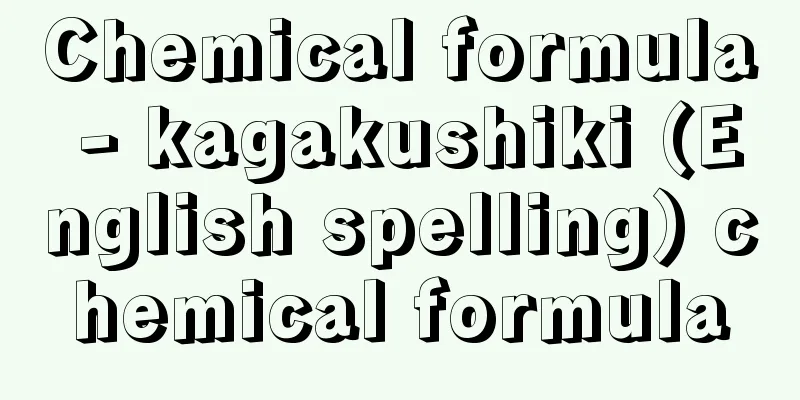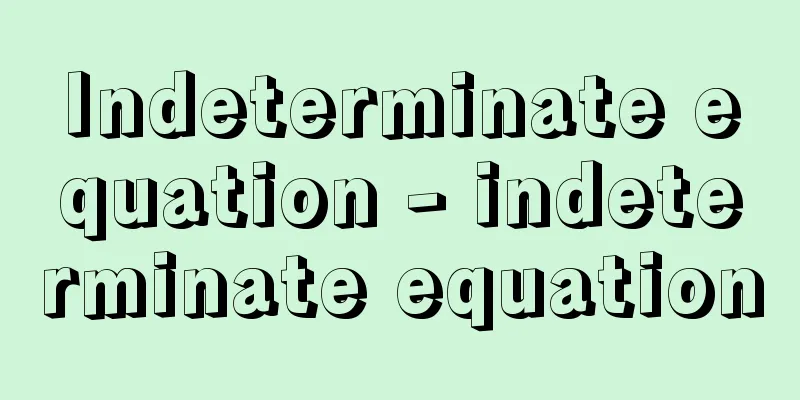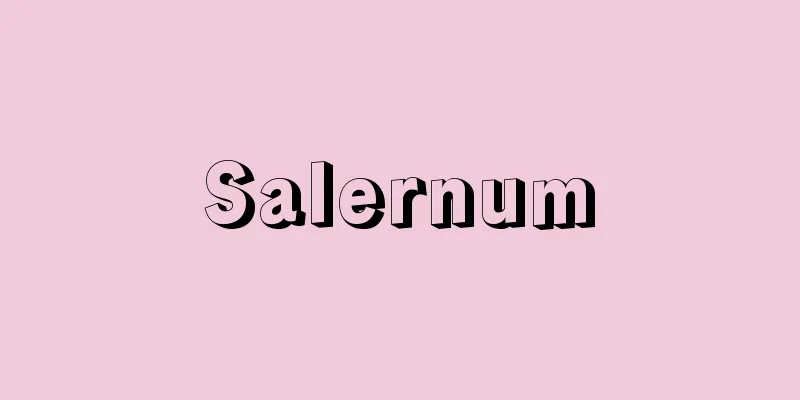Chemical formula - kagakushiki (English spelling) chemical formula

|
A symbol that represents a chemical substance by combining element (atomic) symbols, numbers, etc. There are composition formulas, empirical formulas, molecular formulas, rational formulas, structural formulas, etc. FormulaA formula that shows the type of atoms that make up a substance and the ratio of the number of each type of atom. For simple substances, they all have the same element symbol. This is the simplest chemical formula and is not suitable for distinguishing substances. For example, the chemical formulas of both acetylene and benzene are CH. [Iwamoto Shinbu and Nakahara Katsunori] Empirical formulaThe composition of a compound is experimentally determined by elemental analysis. The composition formula obtained from the experimental results is called the empirical formula, but in most cases, the ratio of the numbers of atoms is not an exact integer ratio due to experimental error. However, when a compound has a well-defined molecule, the value obtained is very close to the integer ratio, so the empirical formula and the composition formula are often considered to be the same. Some compounds have a composition ratio that is not a simple integer ratio, and are called nonstoichiometric compounds, nonstoichiometric compounds, bertholide compounds, etc. For example, there are titanium oxides whose composition changes continuously, such as TiO 0.60 to 1.35 , and these compounds do not have a constant empirical formula, and their composition formula is sometimes written as TiO x ( x = 0.60 to 1.35). [Iwamoto Shinbu and Nakahara Katsunori] Molecular FormulaThe molecular formula can be obtained by measuring the molecular weight of a substance whose chemical formula is known. The molecular formula indicates the type and number of atoms that make up the molecule. From their molecular weights, elemental hydrogen, oxygen, and nitrogen are known to be diatomic molecules, and their molecular formulas are H2 , O2 , and N2 . Phosphorus has an allotrope with the molecular formula P4 , and sulfur has an allotrope with the molecular formula S8 . Acetylene and benzene, which have the same chemical formula, have molecular weights of 26.04 and 78.11, respectively, which are two and six times the sum of the atomic weights of CH, 13.02 , and therefore have molecular formulas C2H2 and C6H6 . For substances that do not have molecules consisting of a small number of clearly independent atoms, such as covalently bonded macromolecules, ionic crystals, and polymeric compounds, it is not possible to write an accurate molecular formula, so they are often expressed as a composition formula or a rational formula, as described below. [Iwamoto Shinbu and Nakahara Katsunori] Rational formulaA rational formula is a formula that is a rewrite of a compositional formula or molecular formula, dividing it into atomic groups such as radicals, acid ions, and ligands. For example, the compositional formula of alum is AlKH 24 O 20 S 2 , but if it is expressed as KAl(SO 4 ) 2・12H 2 O, which indicates the component ions, it is found to be potassium aluminum sulfate dodecahydrate. Ethanol (ethyl alcohol) and dimethyl ether both have the same molecular formula C 2 H 6 O, but if they are expressed as rational formulas as in (2), they are found to be alcohols with an ethyl group C 2 H 5 - and ethers with two methyl groups -CH 3 , respectively. Polyvinyl chloride is a polymer whose molecular formula is difficult to determine, but it is often expressed as a rational formula showing the constituent units, such as (CH 2 CHCl) n . In chemistry, it is convenient to use rational formulas, and they are widely used instead of molecular formulas. In organic compounds and complexes, the term molecular formula often refers to the rational formula. [Iwamoto Shinbu and Nakahara Katsunori] Structural formulaStructural formulas are more detailed versions of rational formulas, showing the geometrical relationships of the bonds between each atom. They are widely used for covalent compounds, and are particularly important for organic compounds that have the same molecular formula but different properties, i.e., many isomers. Covalently bonded atoms are connected by lines called valences, with one line representing a single bond, two lines representing a double bond, and three lines representing a triple bond. In the case of ethanol and dimethyl ether, the example is shown in (3), but when there is no risk of the various atomic groups in the molecule being confused with others, structural formulas that incorporate elements of the rational formula that groups together functional groups are also widely used ( (4)). Aromatic rings such as benzene rings and aliphatic rings such as cyclohexane rings are usually represented as polygons such as hexagons, without showing the individual atoms and omitting the hydrogen atoms bonded to the carbon atoms ( ). In a benzene ring, single and double bonds are not alternately connected between carbon atoms, each bond is equivalent, and the ring is a regular hexagon, so a formula with a circle inside a hexagon is often used. All cyclohexane rings are represented as hexagons with one valence. Examples including such simplified structural formulas are shown in , but among these, for example, carbon dioxide molecules are linear and water molecules are V-shaped, so they are often written like this. Diamminedichlorideplatinum(II) is a square planar complex, with platinum and each of the coordinated atoms on the same plane, but in lactic acid, the central carbon atom is at the center of a tetrahedron and each of the atoms bonded to it occupy the vertices of the tetrahedron, giving it a three-dimensional structure. Planar structural formulas are convenient and widely used for many organic compounds, but optical isomers and other more complex compounds are represented by three-dimensional structural formulas or projection formulas, which can show the structure more accurately. Inorganic compounds have much more complex bonding patterns than organic compounds, and the three-dimensional structures are diverse, so three-dimensional structural formulas are often used, although they are used for simple covalent molecules. [Iwamoto Shinbu and Nakahara Katsunori] ©Shogakukan "> Types of chemical formulas (Figure A) Examples of cyclic compounds ©Shogakukan "> Example of structural formula (Figure B) ©Shogakukan "> Example of simplified structural formula (Figure C) Source: Shogakukan Encyclopedia Nipponica About Encyclopedia Nipponica Information | Legend |
|
元素(原子)記号、数字などを組み合わせて化学物質を表現する記号。組成式、実験式、分子式、示性式、構造式などがある。 組成式物質を構成する原子の種類と、それぞれの原子の個数の比を示す式。単体であれば、すべて元素記号と同じになる。化学式としてはもっとも簡単なもので、物質を区別するのには適さない。たとえば、アセチレンもベンゼンも組成式はCHになる。 [岩本振武・中原勝儼] 実験式化合物の組成は元素分析によって実験的に定められる。実験結果から得られた組成式が実験式であるが、通常の場合、原子の個数の比は、実験誤差のために、厳密な整数比にはならない。しかし、化合物が明確な分子をもつときには、整数比にきわめて近い値が得られるので、実験式と組成式は同じものであるとされることが多い。 化合物によっては、構成原子の比が簡単な整数比にならないものがあり、それらは不定比化合物、非化学量論化合物、ベルトライド化合物などとよばれる。たとえば、チタンの酸化物にはTiO0.60~1.35のような、組成が連続的に変化するものがあり、この種の化合物では実験式が一定にならず、TiOx(x=0.60~1.35)のように組成式が書かれることもある。 [岩本振武・中原勝儼] 分子式組成式がわかっている物質の分子量を測定すると分子式が得られる。分子式は分子を構成する原子の種類と個数を示す。単体の水素、酸素、窒素は分子量から二原子分子であることがわかり、それらの分子式はH2、O2、N2となる。リンにはP4、硫黄(いおう)にはS8の分子式をもつ同素体がある。同一の組成式をもつアセチレンとベンゼンでは、分子量がそれぞれ26.04、78.11となり、CHにおける原子量の和13.02の2倍および6倍となるので、分子式はC2H2およびC6H6となる。 共有結合性巨大分子、イオン結合性結晶、高分子化合物のような、明確に独立した少数原子よりなる分子をもたない物質では、分子式を正確に書くことができないので、組成式、あるいは次に述べる示性式で表すことが多い。 [岩本振武・中原勝儼] 示性式組成式あるいは分子式を、基、酸イオン、配位子などの原子団に分けて書き改めたものが示性式である。たとえば、ミョウバンの組成式はAlKH24O20S2となるが、成分イオンなどを明示したKAl(SO4)2・12H2Oの示性式で表せば、硫酸アルミニウムカリウム12水和物であることがわかる。エタノール(エチルアルコール)もジメチルエーテルも、分子式はC2H6Oと同じになるが、の(2)のように示性式で示せば、それぞれエチル基C2H5-をもつアルコール、メチル基-CH32個をもつエーテルであることがわかる。ポリ塩化ビニルは分子式を定めにくい高分子であるが、(CH2CHCl)nのように、構成単位を示す示性式で表すことが多い。化学的には示性式を用いるのが便利であり、分子式にかわって広く用いられ、有機化合物や錯体では、分子式といえばむしろ示性式をさす場合が多い。 [岩本振武・中原勝儼] 構造式示性式をさらに詳しくして、各原子が結合している幾何学的関係を示すのが構造式である。共有結合性の化合物に広く用いられ、とくに有機化合物では同じ分子式でも性質の違うもの、すなわち異性体が多いものに欠かすことのできない重要な式となっている。共有結合している原子の間は価標とよばれる線で結び、1本で単結合、2本で二重結合、3本で三重結合を表す。エタノールとジメチルエーテルの例ではの(3)のようになるが、分子内の各種原子団が他と混同されるおそれのないときは、官能基をひとまとめにした示性式の要素を取り込んだ形の構造式も広く用いられる(の(4))。 ベンゼン環のような芳香族の環、シクロヘキサン環のように脂肪族の環も、各原子を示さず、炭素原子に結合した水素原子も省略した、六角形のような多角形で表すことが普通である()。ベンゼン環では、炭素原子間に単結合と二重結合が交互に連なっているわけではなく、各結合は等価であり、環は正六角形になっているので、六角形の中に丸を書いた式もよく使われる。 シクロヘキサン環はすべて一本価標の六角形で示される。このような簡略化された構造式を含めた例をに示すが、これらのなかで、たとえば二酸化炭素分子は直線状、水分子はV字形の構造をもつので、このように書くことも多い。また、ジアンミンジクロリド白金(Ⅱ)は平面正方形型錯体で、白金および各配位原子は同一平面上にあるが、乳酸では中央の炭素原子が四面体の中心にあって、それに結合している各原子が四面体の頂点を占める立体構造をもっている。多くの有機化合物では平面構造式で構造を示すことができるので、便利なため広く用いられているが、光学異性体その他さらに複雑なものはより正確に構造を示すことができる立体構造式、投影式などで示す。無機化合物では結合様式が有機化合物よりもはるかに複雑であり、立体構造も多様なので、簡単な共有性分子には使われるが、多くの場合、立体構造式のほうが用いられる。 [岩本振武・中原勝儼] ©Shogakukan"> 化学式の種類〔図A〕 環式化合物の例©Shogakukan"> 構造式の例〔図B〕 ©Shogakukan"> 構造式の簡略化の例〔図C〕 出典 小学館 日本大百科全書(ニッポニカ)日本大百科全書(ニッポニカ)について 情報 | 凡例 |
Recommend
Nagaya
A style of building with several houses attached ...
Manabu Sano - Manabu Sano
Social activist and historian. Born in Oita Prefe...
Active Center - Catalytic Center
A specific site on the surface of a solid catalys...
Development Review Board
…In urbanization control zones, permission is not...
Wilms tumor
...The more mature type is ganglioma, which is a ...
Ray
A magazine for young women published by Shufunotom...
Tsunami - Tsunami
A wave that is generated mainly by a sudden chang...
Delacroix
A representative French painter of Romanticism. Bo...
Kamioka mine
This non-ferrous metal mine was located in the Ka...
Shipping wholesaler
In the Edo period, shipping businesses owned ships...
Tanegashima Tokitaka
A military commander during the Sengoku period. H...
Hair herbal medicine - Kehaegusuri
A drug that stimulates hair roots and promotes hai...
Antwerp - Antwerp (English spelling)
Antwerp is a port city and the capital of the pro...
Yoshihisa Kuzu
1874-1958 A nationalist from the Meiji to Showa e...
Michael Addition - Michael Fuca
Also known as Michael addition. A reaction in whi...









